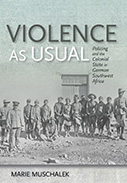Violence As Usual: Policing And The Colonial State In German Southwest Africa

Author: Marie Muschalek
Publisher: Ithaca, NY: Cornell University Press, 2019. 270p.
Reviewer: S. Jonathan Wiesen | September 2021
Marie Muschalek’s study appears at an auspicious time. In the United States, daily police shootings of African American men and the murder of George Floyd have provoked a national reckoning about structural racism and anti-Black violence. Likewise in Germany in 2020, criminologists published an exhaustive study that revealed patterns of brutality and racism within the country’s police departments. While black and brown communities have long grasped the constitutive role that the police play in the enforcement of racial and social hierarchies, the crisis has now entered the wider transnational public consciousness (though whether this heightened consciousness will translate into tangible change remains an open question).
For their part, historians have long paid attention to the intersections between racial violence and policing. The most recent contribution to this scholarly literature is Violence as Usual, which turns its attention to German Southwest Africa during and after the Herero and Nama genocide from 1904 to 1908. What, historian Marie Muschalek asks, were the origins and functions of everyday police violence in the large and sparsely populated settler colony that is today Namibia? What social meanings were assigned to this violence? What did the routine practices of punching, kicking, and whipping Africans say about colonial rule and the self-understanding of Germans?
In the process of taking up these questions, Muschalek challenges reigning assumptions about the colonial state. Historians have tended to emphasize the planned, coordinated nature of imperial violence. And not without reason. By its very definition, genocide depends on an intention to destroy part or the whole of an ethnic group, and it typically involves the state and its propaganda apparatuses. Less sweeping, more ostensibly spontaneous acts of colonial violence are often interpreted as symptomatic of a weakened state, one in which community violence fills a power vacuum. In both cases, the state is at the center of the analysis. Muschalek moves away from this state-centered approach by offering a micro-historical survey of police brutality that focuses on the work of midlevel “soldier-bureaucrats” and their efforts to cement racial hierarchies while enforcing a punishing system of forced labor.
In the process, her book pushes us to rethink the meaning of violence. With policing, it is tempting to see brutal acts as violations of legal and moral norms. Even as the everyday application of excessive force in the United States comes into clearer view, it is assumed that police regulations prohibit punching and slapping, at least by the letter of the law. Yet, by exploring forms of “quotidian violence” in Southwest Africa, Muschalek cautions us against this kind of reductive thinking. In the German colony, police violence–which included shooting to kill—was not only omnipresent but was backed by informal, makeshift rules about the correct forms of punishment. Police brutality was neither aberrant nor frowned upon, and such violence enforced honor codes and reflected masculine norms among both black and white police officers in this mixed race Landespolizei. In an elegantly written but painful section on the materiality of violence, Muschalek describes the use of whips, shackles, guns, and other policing tools, which were all instrumental parts of everyday life. Their use was not a brutal abdication but a full expression of proper policing.
Police violence was both normalized and utterly terrifying to those who experienced it. Members of the Landespolizei rounded up people to labor in the–ultimately unprofitable–agricultural and mining industries of German Southwest Africa. They hunted down missing workers, beat shirkers, and shackled resisters around the neck and marched them on long treks. Brutality was also endemic within the police force, reflecting the reality of a predominantly white institution that employed black policemen. In a fascinating opening anecdote, Muschalek relates the story of Hans, an African policeman punished for questioning a white superior officer’s command. After a staff sergeant whips him for insubordination, a distressed Hans beats a random prisoner with the butt of his rifle. This use of his weapon is deemed incorrect, and Hans is forced to reapply violence to the hapless prisoner, this time with the proper tool—the very whip with which he himself has been beaten. Caught in a cycle of racialized violence, Hans wants nothing more of policing and ultimately kills himself.
Drawing on stories like these, Muschalek develops the concept of “educative violence.” She uses this term to describe forms of punishment that did several kinds of work at once: enforce hierarchies, address slights to authority and honor, and teach both subaltern policemen and the local population how to put in a good day’s work and respect their German landlords. This “run-of-the mill” violence did not signal a broken system of authority but instead reinforced informal structures of order in a sparsely regulated frontier that had 70,000 Africans and 15,000 Germans on the eve of World War I. Indeed, the entire regulation of German Southwest Africa depended on this police force, which served myriad roles in the absence of political functionaries. As Muschalek writes, the colonial intermediaries in this region “were the state” (161). They served as scribes, interpreters, tax collectors, and mining regulators. They enforced health measures and hunting privileges and even made meteorological observations. And while carrying out these tasks, they had a monopoly on both the authority and the tools that enabled them to apply violence on a whim.
Muschalek convincingly shows that in this colonial setting, policemen made up the “sinews of the new social body” (4). Theoretically informed, the study makes productive use of Alf Lüdtke’s concept of Eigensinn and Michel de Certeau’s “tactics.” Both concepts aid Muschalek as she paints a picture of how workers give meaning to everyday practices, in this case policing. Still, there are several underdeveloped themes in Violence as Usual. First, we get little sense of how the mass killing of tens of thousands of Africans during the genocide affected policing in the years that followed. The colonial war had destroyed political and social structures among Africans and thus allowed some of them to reinvent themselves as policeman. But how did genocide affect the practices outlined in the book? Was police violence strategically tempered or, alternatively, expanded in the midst of mass trauma?
Second, while the book presents a fascinating case study of a multiracial police force, composed of two-thirds Germans and one-third Africans, we do not get an intimate sense of how the two groups interrelated. The picture that emerges is one of affinity and antagonism: white and black policemen worked together side by side, even as white officers punished black subordinates. But the reader is still left with questions. Despite the prevalence of white supremacy and crude stereotypes about Africans (for example, that their skin was harder than whites’ and therefore less vulnerable to pain), was there any camaraderie between white and black policemen? Did the shared experience of meting out violence bind them together? While African policemen rarely got promoted, one may wonder whether they nonetheless garnered respect in other ways. A multiracial colonial police force was rare in colonial Africa, and it will be up to future scholars to look even more deeply at the affective ties that bound together the men of the uniquely integrated Landespolizei.
These issues notwithstanding, this is a timely book that offers a fine-grained and theoretically rich analysis of police violence in an imperial setting. Muschalek’s illuminating and troubling case study raises questions that are relevant to our own time: what is the relationship between coordinated and more improvised forms of violence? How does state violence convey cultural and social meaning and construct identity for both its perpetrators and victims? How does the culture of policing draw on traditional codes of masculinity and martial honor? The laws against police brutality may be more formalized today, but violence is still woven into the daily practice of policing, a point vividly made by Black Lives Matter activists across the globe in the summer of 2020. Finally, Violence as Usual reminds readers that a more racially diverse police force is as capable of meting out racial violence as its racially exclusionary counterpart. In the German Southwest Africa of the early twentieth century, African and German policemen rode side-by-side on horseback and posed together confidently in photographs, ready as they were to seize laborers, capture runaways, and whip, beat, and kill Black people in the name of colonial order and profits.
Jonathan Wiesen, Professor, Department of History, University of Alabama at Birmingham


